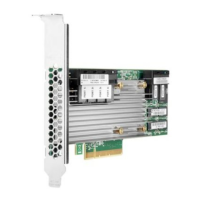Global spare
A global spare drive replaces a failed drive in any array, as long as:
• The drive type is the same.
• The capacity of the global spare drives is equal to or larger than the capacity of the failed drive.
A global spare drive activates any time a drive fails within a fault tolerant logical drive or CacheCade SSD
volume. For RAID 0 logical drives, the global spare will active when a member drive reports a predictive
failure.
Drive rebuild
If a drive, which is configured as RAID 1, 5, 6, 10, 50, or 60 fails, the firmware automatically rebuilds the
data on a spare or replacement drive to prevent data loss. The rebuild is a fully automatic process.
Monitor the progress of drive rebuilds in the Background Processes in Progress window.
Access the drive rebuild rate by selecting Set Adjustable Task Rate under the More Actions menu then
locating it under the Priority Percentage column. Enter a number from 1 to 100. The higher the number,
the faster the rebuild will occur (and the system I/O rate might be slower as a result).
Foreign configuration import
A foreign configuration import is a RAID configuration that exists on a replacement set of drives that you
install in a computer system. You can use the MR Storage Administrator to import the foreign
configuration to the controller or clear the foreign configuration so that you can create a configuration
using these drives.
Transformation
Array transformations
Expand array
Increase the capacity of an existing array by adding currently existing unassigned drives to it. Any drive
that you want to add must meet the following criteria:
• It must be an unassigned drive.
• It must be of the same type as existing drives in the array (for example, SAS HDD, SAS SSD, SATA
HDD, or SATA HDD).
• It must have a capacity no less than the capacity of the smallest drive in the array.
This operation uses the Modify Array option in the HPE MR Storage Administrator user interface. This
feature is supported when there is a single logical drive configured in the array.
Logical drive transformations
Transportable controller
The controller firmware supports a transportable battery-backed cache memory to recover the data from a
faulty server. This transportable controller recovers from a faulty server by moving the entire controller to
a new replacement server.
In this design, the controller firmware assumes that the new server has the same configuration. That is,
the configuration includes the same server generation and family, and logical drives are migrated to the
new target server to facilitate cache flush when the data is restored.
20 Features

